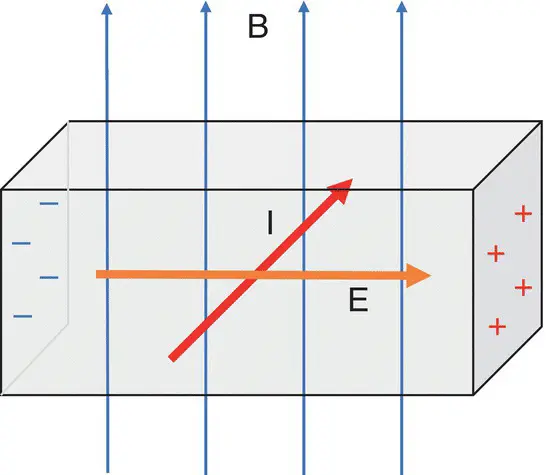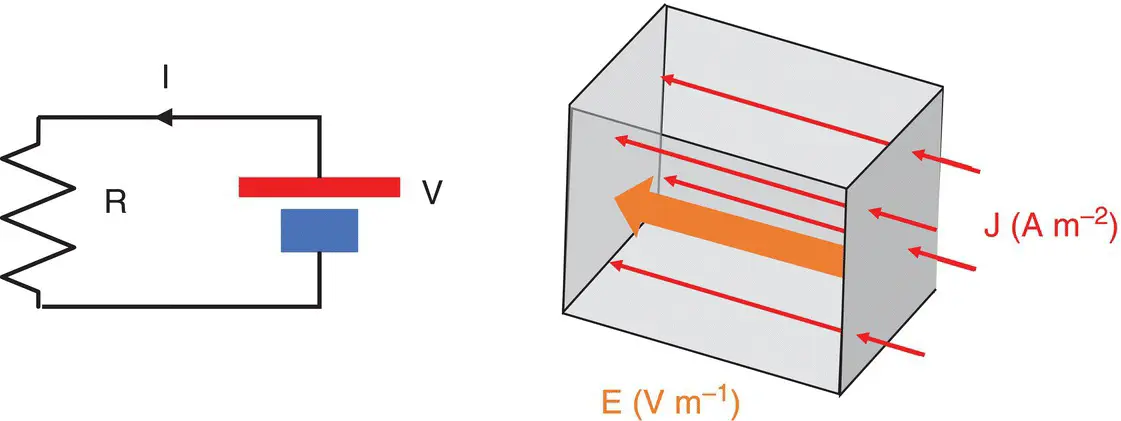LORENTZ AND HYDRODYNAMIC FORCES
Moving charges are subject to an additional force, the Lorentz force . Charge moving within an external magnetic field produces an electric field by the hydrodynamic or Hall effect .
The magnitude of the Lorentz force on a charge Q possessing velocity v is given as
(2.20) 
The direction of the force can be determined by Fleming’s left‐hand rule.
Magneto‐hydrodynamic effect
A similar effect is the generation of an electric field E by the flow of charge within an external magnetic field ( Figure 2.26). This is analogous to the Hall effect observed in semiconductors.
(2.21) 

Figure 2.26 Magneto‐hydrodynamic and Hall effect.
In terms of induced voltage or electrical potential, V , where
(2.22) 
and d is the distance between charged surfaces (as in a capacitor), we have an induced voltage
(2.23) 
The effect is most commonly encountered in MRI as an artefact in ECG traces.
The laws of induction follow from Maxwell’s third equation or Faraday’s law. If we consider a wire loop within a time‐varying B‐field the magnitude of the induced E‐field is [3]
(2.24) 
This applies for both the electric field induced by the imaging gradients responsible for peripheral nerve stimulation (PNS), and the electric field induced by the RF B 1‐field responsible for SAR and tissue (and implant) heating. The direction of E follows a left‐hand rule, as any magnetic field produced by the induced current in the wire opposes the rate of change of flux that induced it.
Faraday induction from the gradients
Biological tissues conduct electricity by means of water and electrolytes. Rather than considering electrical current in tissue (as in wires), we consider the current density J, a vector ( Figure 2.27)
(2.25) 

Figure 2.27 Ohm’s law in a circuit and a volume conductor.
σ is the tissue conductivity in siemens per meter (S m −1). Some representative values are shown in Table 2.3.
Table 2.3 Tissue conductivity at various frequencies. Electrical properties from https://itis.swiss/virtual‐population/tissue‐properties/databaseafter [4].
| Tissue |
Conductivity (S m −1) |
| 10 Hz |
1 kHz |
100 MHz |
| Bone (cortical) |
0.02 |
0.02 |
0.064 |
| Brain (WM) |
0.028 |
0.063 |
0.32 |
| Fat |
0.038 |
0.042 |
0.068 |
| Heart muscle |
0.054 |
0.11 |
0.73 |
| Liver |
0.028 |
0.041 |
0.49 |
| Muscle |
0.20 |
0.32 |
0.71 |
In practice conductivity may be anisotropic, e.g. along a muscle fiber as opposed to across it; or, at radio frequencies, it may be complex with real and imaginary components. For now we shall assume the simplest situation: isotropic, non‐complex but frequency dependent. Human anatomy, with irregular shapes and differing tissue conductivities, will exhibit much more complex behavior, with E‐field lines and current loops being altered by tissue boundaries and electrostatic charges induced on these boundaries according to Gauss’s Law.
Induced fields from movement within the static fringe field gradient
Movement through the static fringe field gradient dB/dz exposes tissue to a changing magnetic flux, and hence induces an electric field and current density. Restricting this discussion to the z‐direction only
(2.26a) 
(2.26b) 
The induced E and J are greatest for the highest level of dB/dz, i.e. close the scanner bore entrance, and scale with velocity. This mechanism is thought to be the cause for some of the acute sensory effects experienced around high field magnets (see Chapter 3).
Example 2.10 Movement in the fringe field gradient
A staff member moves towards the magnet at 1 ms −1in a fringe field gradient of 5 Tm −1. What is the maximum induced electric field and current density around their head?
Use Equation 2.26 with r = 0.08 m and conductivity of 0.2 Sm −1


The eddy currents induced by movement generate a magnetic field which opposes the change in magnetic flux. This is Lenz’s law, a clarification upon Faraday’s law of induction. An example of this can be observed by introducing a sheet of non‐ferromagnetic metal such as aluminium or copper into the bore of the magnet. If you position the sheet vertically and transversely (normal to B 0) and then allow it to drop towards the horizontal, the flux from B 0changes as the angle to B 0increases and induced magnetic field will oppose B 0. The ensuing attractive force opposes the gravitational force and the sheet will tip in slow motion down towards the horizontal. Similarly, moving a non‐ferromagnetic conducting object in the fringe field gradient will result in resistance to that motion. Make sure the metal you use is non‐ferromagnetic.
Induction from the radiofrequency exposure
In some respects, the calculation of induced E from the RF exposure is easier than for the gradients, because to a good first approximation, we can consider B 1as being uniform in space. The power density P V, follows from a volumetric version of the Ohm’s law relation “power equals voltage times current”:
Читать дальше
























